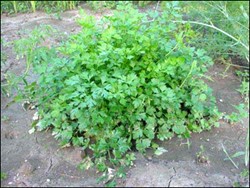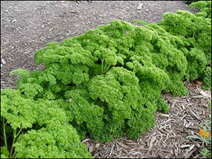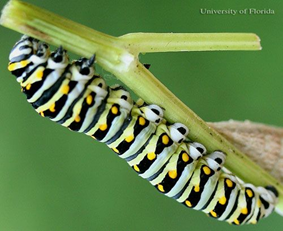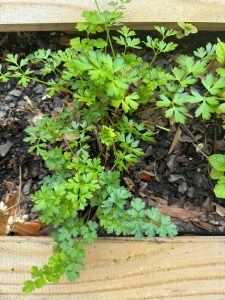Are you a fan of fresh aromatic herbs in your dishes? If so, growing herbs right at home might just become your new favorite hobby. In this guide, we’ll explore how to grow parsley from the comfort of your own home, including some commonly grown varieties that do well in Central Florida. We’ll also highlight specific growing conditions required by herbs for optimal growth, pest and disease management, and seasonality.
Commonly Grown Varieties
Easy to grow and cook with, parsley is a bright green herb that adds variety to the garden. It adds an aromatic pop of color and brings flavor along with vitamins A, C, and K, as well as several B vitamins, calcium, and iron to your dishes.
Not only does parsley add a burst of flavor and visual appeal to countless recipes, it’s also relatively easy to cultivate, making it perfect for beginners and seasoned gardeners alike.
- Italian Flat-leaf Parsley (Petroselinum crispum var. neapolitanum):
- Italian flat-leaf parsley is the most popular variety, known for its flat, deeply serrated leaves and robust flavor.
- USDA Hardiness Zone: 5 to 9.
- Growing conditions: Full sun to partial shade with well-draining soil.
- Uses: This variety is perfect for garnishing dishes, adding flavor to sauces, soups, and salads.

- Curly Parsley (Petroselinum crispum var. crispum):
- Curly parsley is another widely grown variety, prized for its tightly curled, bright green leaves and slightly peppery flavor.
- USDA Hardiness Zone: 5 to 9.
- Growing conditions: Full sun to partial shade with well-draining soil.
- Uses: Curly parsley is often used as a garnish and adds texture and flavor to dishes like potato salad, and grilled meats.
- Moss Curled Parsley (Petroselinum crispum ‘Moss Curled’):
- Moss curled parsley features tightly curled, dark green leaves and a strong flavor.
- USDA Hardiness Zone: 5 to 9.
- Growing conditions: Full sun to partial shade with well-draining soil.
- Uses: This variety is excellent for garnishing and adds a decorative touch to dishes. It can also be used in cooking, particularly popular in Mediterranean and Middle Eastern cuisines.

- Hamburg Parsley (Petroselinum crispum var. tuberosum):
- Hamburg parsley, also known as root parsley, is grown for its edible root as well as its flavorful leaves.
- USDA Hardiness Zone: 5 to 9.
- Growing conditions: Full sun to partial shade with well-draining soil.
- Uses: The roots can be cooked or eaten raw, like carrots or parsnips, while the leaves can be used in the same way as other parsley varieties.
- French Parsley (Petroselinum crispum var. latifolium):
- French parsley, also known as broad-leaf parsley, has large, flat leaves and a robust flavor.
- USDA Hardiness Zone: 5 to 9.
- Growing conditions: Full sun to partial shade with well-draining soil.
- Uses: This variety is ideal for chopping and adding to soups, stews, sauces, and marinades to add a fresh taste to the dish.
Growing conditions
Soil Preparation
Parsley prefers moist but well-draining soil. In Central Florida, it is beneficial to grow parsley in raised beds to better control moisture retention and soil texture. Since Florida soil tends to be sandy, using soils rich in organic matter will help your herb thrive. Parsley has an optimal pH range of 5.5 to 6.7.
If you don’t already know your soil conditions, a great place to start is with a soil test. UF/IFAS Extension provides Soil Testing Services that are affordable and available to the public. The results will provide valuable information about your soil’s pH, fertility levels, nutrient content, and how to amend your soil to achieve an optimal pH range for parsley.
Sunlight
Parsley prefers partial shade to full sun, especially in the warmer months of Central Florida. Parsley enjoys sunlight, but protection from Florida’s intense afternoon sun can prevent the plant from wilting and scorching. Aim to provide parsley plants with at least 4-6 hours of sunlight daily. In the winter, parsley can tolerate cooler temperatures, but you will want to protect the plant from frost.
Read more about protecting your veggies from the cold here.
Fertilization
First things first, get your soil tested to determine which fertilizer is right for your garden.
Before planting or transplanting parsley, amend the soil with compost and fertilizer to provide essential nutrients. Parsley thrives in nutrient rich soil. Follow the recommendations from your soil test to determine the appropriate fertilizer for your garden. Parsley will benefit from a balanced fertilizer. For dosage, follow the directions on the product label.
Read more about fertilizers in our Fertilizer Fundamentals series:
- Fertilizer Fundamentals: How to Choose the Right One – UF/IFAS Extension Pasco County (ufl.edu)
- Fertilizer Fundamentals: How to Apply Fertilizer – UF/IFAS Extension Pasco County (ufl.edu)
- Fertilizer Fundamentals: The Best Time to Fertilize – UF/IFAS Extension Pasco County (ufl.edu)
Pests and Diseases
Pests
While parsley is relatively pest-free, it can be susceptible to certain insects like aphids, caterpillars, and leafhoppers. Keep an eye out for any signs of infestation, such as holes in the leaves or visible pests on the foliage. Remember to look under the foliage and not just on top as many insect pests hide from the sun under the leaf.
- Aphids: These small, soft-bodied insects can cluster on the undersides of parsley leaves, sucking sap and causing wilting. Signs include distorted growth and sticky honeydew residue on the foliage. Honeydew is insect waste (aka: poo) left behind from feeding.
- Treatment: Use a strong jet of water to dislodge aphids from the plant. Spraying insecticidal soap or neem oil will help control their numbers. Always follow the label instructions on the product to prevent plant injury.
- Caterpillars: Caterpillars, such as those of the parsley worm or may feed on parsley leaves, leaving behind chewed foliage. Keep in mind that some caterpillars you come across in the garden are the larval stage of butterflies, like the eastern black swallowtail. If you’re planting to attract pollinators, this is great! Happy pollinator feeding time! However, if you’re planting to harvest the herbs for your own use, you can attempt to relocate the caterpillars. Butterfly larvae (caterpillars) may find their way back to the plants where you originally found them if relocated nearby, so it’s best to plant an extra plant or two just for pollinator feeding and relocation.
- Treatment: Handpick caterpillars from the plants and relocate them or dispatch them in a bucket of soapy water.

- Leafhoppers: These small, wedge-shaped insects feed on the plant sap and can cause stippling or yellowing of parsley leaves.
- Treatment: Introduce natural predators like ladybugs or lacewings to control leafhopper populations. Or you can spray insecticidal soap to control their numbers, always follow the label instructions on the product.
Diseases
Parsley is also vulnerable to fungal diseases like powdery mildew and root rot, especially in the humid conditions in Florida. Good cultural practices like keeping air circulating around your parsley plants (avoid overplanting) and avoiding overhead watering will minimize moisture on the leaves.
- Powdery Mildew: Powdery mildew appears as a white, powdery coating on parsley leaves. It can cause leaf distortion and premature leaf drop. It is common in humid in humid conditions, so check your plant for these signs regularly.
- Treatment: To prevent the disease, space your plants out and grow them in a pot or raised bed with well-draining soil to improve air circulation. To treat diseased plants, apply fungicidal sprays containing sulfur or copper to control powdery mildew. Remember, always follow the label instructions on the product.
If the plant has a severe case, remove, and dispose of the sick plant parts to prevent the spread of the disease.
- Root Rot: Root rot is exactly what it sounds like. When plants grow in excessively wet conditions, the roots don’t have enough air, and they begin to rot. These conditions attract fungi and molds that infect the roots and kill them and the plant they support.
- Treatment: Avoid overwatering and ensure proper drainage around parsley plants. There is no saving a plant with root rot, remove the affected plants and improve soil drainage for the other plants if root rot is detected.
Seasonality
Parsley is a biennial herb that thrives in Central Florida’s mild winters and warm summers. Parsley does love the warmer weather, so that translates to Florida’s winter and early spring months. Since parsley typically grows in Florida as a cool-season annual, plant parsley outdoors in the fall or early spring to take advantage of the cooler temperatures.
Parsley will thrive in the winter and die off in the late spring. In Florida, growing parsley in light shade will prolong the growing season, since the sunshine is intense. Pollinators like bees and black swallowtail butterflies love parsley blooms, so allowing the plant to bolt, or flower, will attract these beneficial critters to your garden!

Pruning Parsley for Optimal Growth
Pruning, or when you selectively remove parts of a plant, will promote bushy growth, prevent the plant from flowering prematurely, and keep the leaves flavorful. Here’s a step-by-step guide on how to prune parsley effectively:
- Identify Growth Points: Parsley grows from a central stem with clusters of leaves branching off of that main stem. Identify the central stem and the points where leaves emerge from the soil. Take sharp scissors or sheers and cut close to the growth point, will allow the plant to direct energy into growing more delicious, bushy foliage.
- Prune Regularly: Using clean scissors or pruning shears, snip off the outermost stems just above the point where they emerge from the soil. This encourages new growth from the center of the plant and prevents it from becoming leggy.
- Pruning Guidelines: To harvest parsley, use clean scissors or shears to clip the stems, leaving 2-4 leaves on the plant to continue growth. Avoid cutting more than one-third of the plant at a time to ensure continued growth.
- Remove Flower Buds: Parsley produces pretty, small flowers as they mature. If your goal is to grow parsley ornamentally, or attract pollinators, keep the flowers. But for culinary purposes, it is best to pinch off the flower buds as soon as soon as they appear. The plant will redirect that energy into growing those tasty leaves we all love. Allowing parsley to flower and set seed will shorten its growing season.

Properly pruning parsley will encourage more growth. Photo courtesy of Julia Sirchia UF/IFAS.
How to Harvest and Store Parsley
Harvest parsley leaves as needed throughout the growing season but avoid over-harvesting to allow the plant to continue producing new growth.
In the hottest months of summer, parsley may bolt and go to seed, when you see the plant do this, it is a sign that the plant is at the end of its productive life cycle.
Place the harvested stems in a container of water away from direct sunlight to keep them fresh for immediate use. For a longer storage period, cover the leaves (I use moist paper towels) and store them in the fridge. You can also freeze the cuttings or dry them to make your own seasoning!
Tips for the Floridian Gardener
Florida’s subtropical climate is both a benefit and a disadvantage when growing parsley. Our high temperatures and humidity can be a challenge when trying to cultivate garden plants. Here are some additional tips for growing parsley:
- Select Heat-Tolerant Varieties: Choose parsley varieties that can thrive in hot climates, such as Italian flat-leaf parsley or Moss Curled parsley. These varieties are better suited to withstand Central Florida’s high temperatures and humidity.
- Conscious Planting: In Florida, the best time to plant parsley is during the cooler months of fall and winter. Providing parsley with a bit of afternoon shade will protect it from the effects of intense sunlight.
- Mulch and Water Wisely: Apply mulch around parsley plants to retain moisture in the soil and regulate soil temperature, especially during dry spells and heatwaves. Additionally, ensure parsley receives regular watering, aiming to keep the soil consistently moist but not waterlogged.
- Monitor for Pests and Diseases: Scout for disease symptoms and pests often. For parsley, keep an eye out for common pests such as aphids, caterpillars, and leafhoppers, as well as fungal diseases like powdery mildew. Inspect the foliage regularly and take measures such as using neem oil or manual removal of insect pests. Be proactive in preventing disease by selecting disease resistant varieties where possible (check the labels for references to disease resistance).

Conclusion
With proper care, pest management, and seasonal adjustments, you’ll be well on your way to harvesting parsley right at home. Also, leave a few plants for the pollinators to enjoy! Happy gardening!
Read the series:
- Spice Up Your Life: A Beginner’s Guide to Growing Marjoram
- Spice Up You Life: A Beginners Guide to Growing Sage
- Spice Up Your Life: A Beginners Guide to Growing Lavender
- Spice Up Your Life: A Beginners Guide to Growing Thyme
- Spice Up Your Life: A Beginners Guide to Growing Chives
- Spice Up Your Life: A Beginners Guide to Growing Dill
- Spice Up Your Life: A Beginners Guide to Growing Oregano
- Spice Up Your Life: A Beginners Guide to Growing Parsley
- Spice Up Your Life: A Beginners Guide to Growing Basil
Have a question?
If you have any questions about gardening in Central Florida, please contact UF/IFAS Extension Pasco County at 352-518-0156. For more information on UF/IFAS Extension Pasco County Community Gardens, and how you can join one, visit http://sfyl.ifas.ufl.edu/pasco/. Supervising agent: Dr. Whitney Elmore.
Follow us!
We have several ways to connect. Visit our Facebook, Instagram, Eventbrite, Blogs, Florida-Friendly Facebook, & Website.
Visit our page for more tips and tricks on maintaining a home garden!
More resources from UF/IFAS Extension Pasco County:
- UF/IFAS Extension Pasco County
- UF/IFAS Extension Pasco County Community Gardens
- Dr. Whitney Elmore’s Podcast: Rooted in Florida
More resources from UF/IFAS Extension:
General
- Parsley – Gardening Solutions – University of Florida, Institute of Food and Agricultural Sciences (ufl.edu)
- Parsley – Solutions for Your Life – University of Florida, Institute of Food and Agricultural Sciences – UF/IFAS (ufl.edu)
- HS638/MV105: Parsley—Petroselinum crispum (Mill.) Nym. (ufl.edu)
- UF/IFAS Soil Testing Services
Pollinators
- Celebrate Pollinators: A Sample Plant List! – UF/IFAS Extension Polk County (ufl.edu)
- EENY-504/IN906: Eastern Black Swallowtail: Papilio polyxenes asterius (Stoll) (Insecta: Lepidoptera: Papilionidae) (ufl.edu)
Pests:
Cooking:
Featured image credit: “Fresh Parsley” by larryjh1234 is licensed under CC BY 2.0.
 3
3
